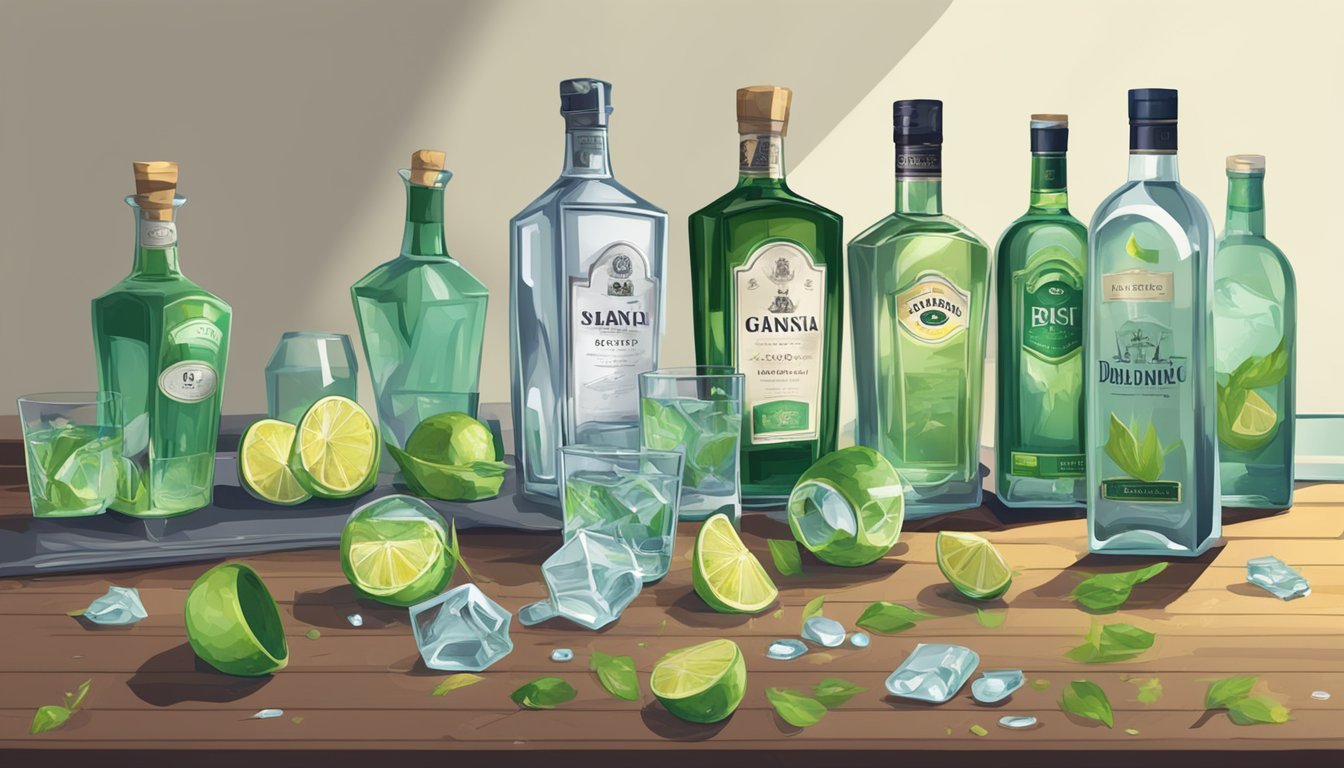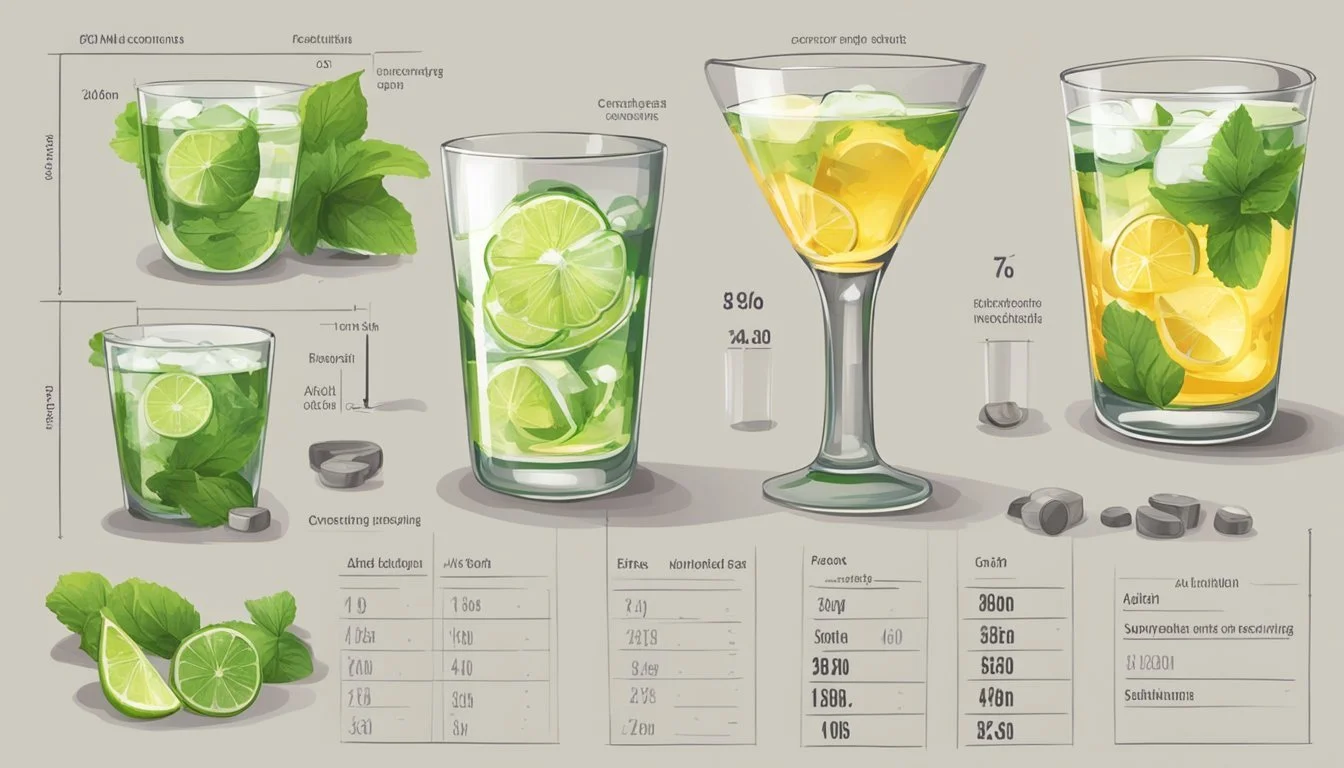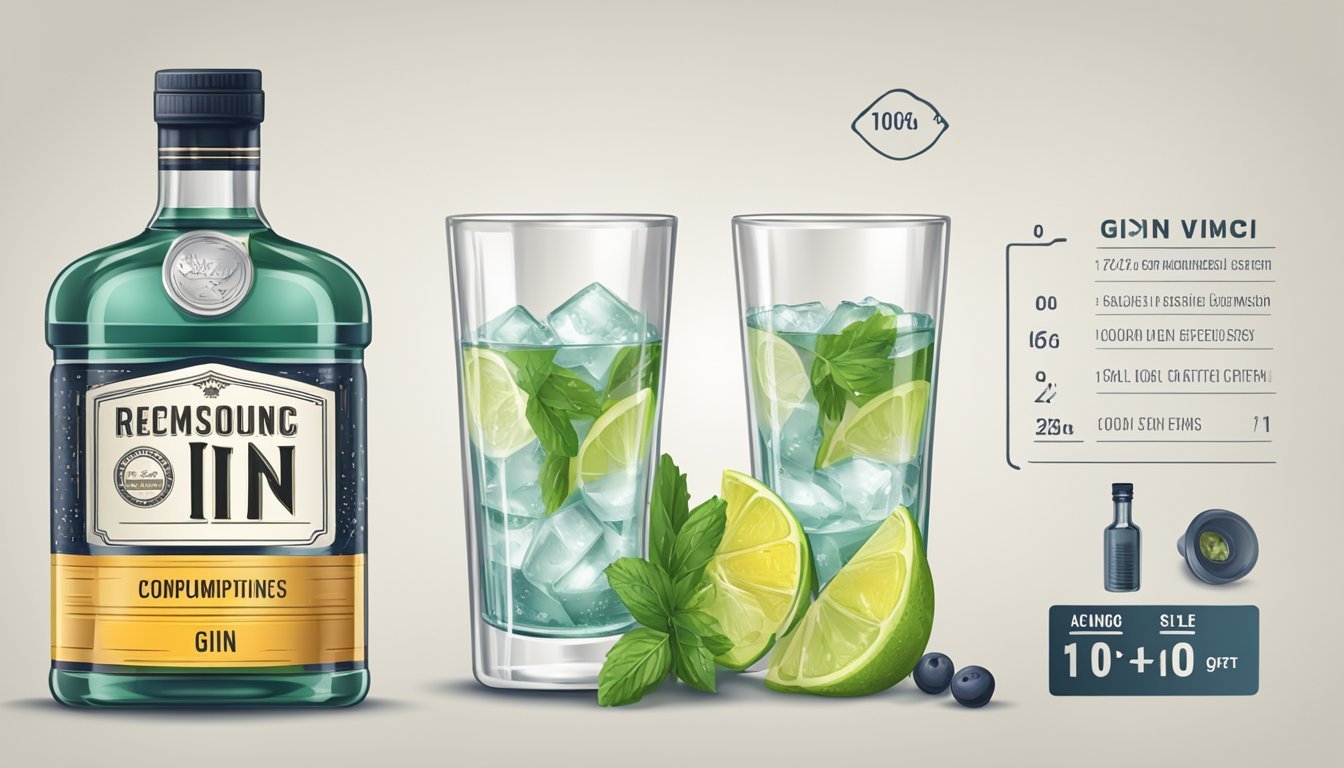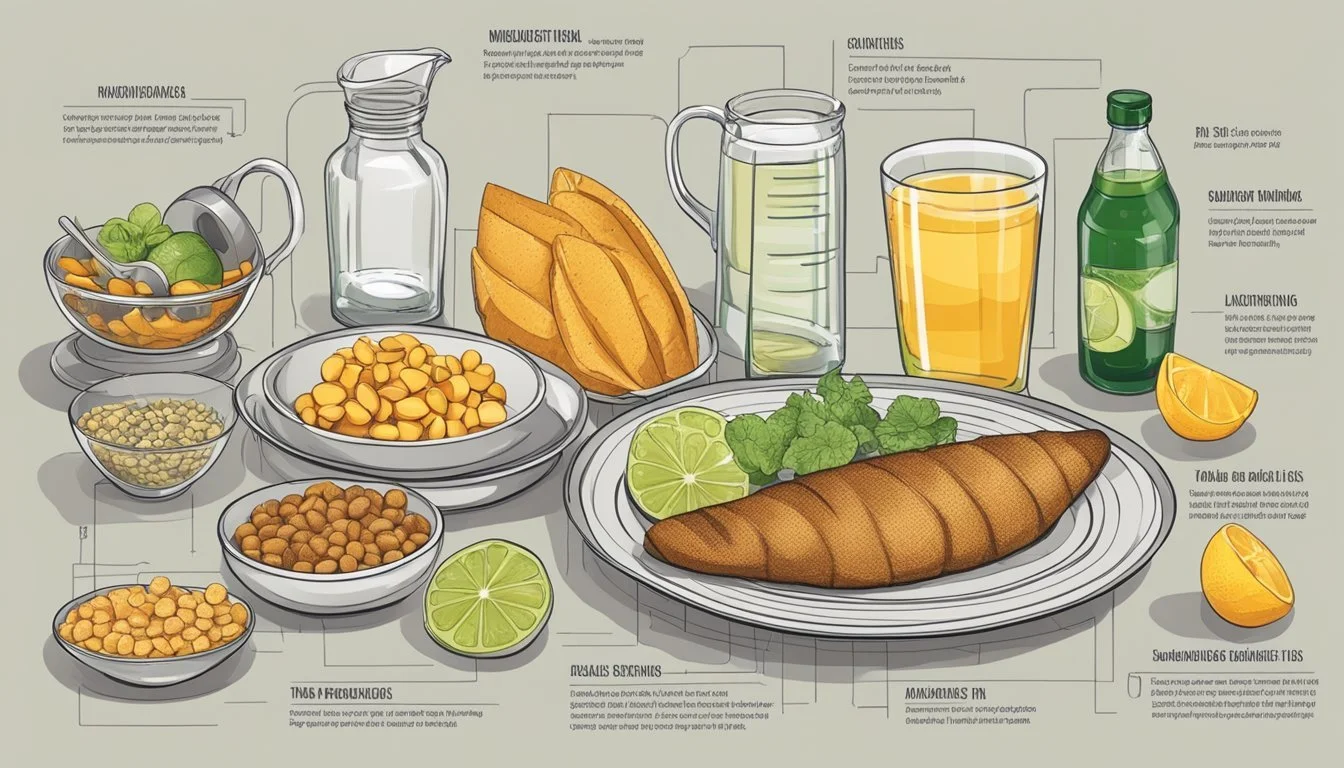How Many Servings of Gin is Too Much
Understanding Safe Consumption
When contemplating the consumption of gin, it’s crucial to strike a balance between enjoyment and health. Consuming gin in moderation can be part of a balanced lifestyle, yet the question of how much is too much remains significant. For most adults, limit gin to one serving per day for women and two servings per day for men to avoid the negative health effects associated with excessive alcohol consumption.
Gin, primarily made from juniper berries, provides approximately 97 calories and 14 grams of alcohol per one-shot serving (1.5 ounces). While gin doesn’t offer significant vitamins or minerals, it can still fit within responsible drinking patterns. Exceeding these amounts regularly can increase the risk of health problems, such as liver disease and various forms of cancer.
Health experts frequently stress the importance of moderation. To keep risks minimal, understanding the recommended limits and adhering to them can ensure that gin remains an enjoyable part of social activities without compromising overall well-being.
Understanding Alcohol Content and Standard Drinks
Knowing the alcohol content in your drink and what constitutes a standard drink is essential to gauge your intake and drink responsibly.
What Constitutes a Standard Drink
A standard drink varies based on the type of beverage. For example:
Beer: 12 ounces with about 5% ABV.
Wine: 5 ounces with about 12% ABV.
Liquor: 1.5 ounces of 80-proof liquor, equating to 40% ABV.
This helps people understand limits across different alcohol types. Each type has typical serving sizes that make up one standard drink, assisting in comparing their strengths and effects.
Gin Alcohol By Volume (ABV)
Gin typically has an ABV ranging from 37.5% to 50%, making it a stronger spirit. This high ABV means that the standard drink measurement for gin is about 1.5 ounces.
Different brands and craft producers may offer variations, some even higher than 50%. Knowing the ABV helps consumers measure their servings and gauge their alcohol intake more accurately.
Comparing Gin to Other Spirits
Compared to other spirits, gin sits at the higher end of the ABV scale. For instance:
Whiskey and Rum: Usually around 40% ABV.
Vodka: Typically 40% ABV but can go higher.
Cocktails: The ABV can vary based on ingredients but often remains lower than neat spirits.
Understanding these variations allows for better control over consumption, especially when mixing different types of alcoholic beverages in one session.
Health Guidelines for Alcohol Consumption
Understanding how much alcohol is safe to consume is essential for maintaining good health. This section outlines recommendations for moderate drinking, the risks associated with heavy and binge drinking, and special considerations for pregnant women.
Moderate Drinking Recommendations
According to the Dietary Guidelines for Americans 2020-2025, moderate drinking for adults means up to one drink per day for women and up to two drinks per day for men. A standard drink is defined as:
12 ounces of beer (5% alcohol content)
5 ounces of wine (12% alcohol content)
1.5 ounces of distilled spirits or liquor (40% alcohol content)
Moderate drinking can lower the risk of heart disease when compared to non-drinkers or heavy drinkers. However, the benefits must be balanced against the risks of increased alcohol intake, particularly in specific populations.
Risks of Heavy Drinking and Binge Drinking
Heavy drinking, defined as consuming more than three drinks per day or more than seven drinks per week for women, and more than four drinks per day or 14 per week for men, poses serious health risks.
Binge drinking, which involves consuming four or more drinks within two hours for women, and five or more drinks within two hours for men, can lead to immediate and long-term health issues.
Health problems associated with heavy drinking and binge drinking include liver disease, certain cancers (such as colorectal, breast, mouth, throat, esophagus, and liver), and the development of alcohol use disorder. Additionally, it weakens the immune system, increases the risk of accidents, and negatively impacts mental health.
Special Considerations for Pregnant Women
Pregnant women or those planning to become pregnant should avoid alcohol entirely. Alcohol consumption during pregnancy can result in fetal alcohol spectrum disorders (FASD), which can cause physical, behavioral, and learning disabilities in the child.
Additionally, alcohol can interfere with proper fetal development and lead to complications such as low birth weight and preterm delivery. The CDC (Centers for Disease Control and Prevention) advises complete abstinence from alcohol during pregnancy to ensure the health and safety of the unborn child.
Healthcare providers and public health organizations consistently emphasize the risks of alcohol consumption during pregnancy and promote alcohol-free pregnancies for the benefit of both mother and child.
The Impact of Gin on Health
Gin, like any alcoholic beverage, has both potential benefits and risks associated with its consumption. The effects of gin can vary from short-term impacts to long-term health consequences, which are essential to understand for making informed decisions.
Short-Term Health Effects of Gin
Consuming gin can have immediate effects on the body. Relaxation and Stress Relief: One of the primary effects people seek is relaxation. In moderation, gin can help reduce stress and anxiety due to its depressant effects on the central nervous system.
Impaired Judgment and Coordination: Even small amounts of gin can impair cognitive functions, leading to poor decision-making and decreased motor skills. This poses risks, particularly in situations requiring alertness, such as driving.
Gastrointestinal Issues: Gin can exacerbate gastrointestinal problems. For instance, it can relax the lower esophageal sphincter, potentially worsening acid reflux. Additionally, drinking gin on an empty stomach may irritate the stomach lining, causing nausea or discomfort.
Long-Term Health Consequences
Long-term consumption of gin can lead to several serious health problems. Liver Damage: Chronic gin intake can result in liver damage, including conditions like fatty liver, hepatitis, and cirrhosis. The liver metabolizes alcohol, and over time, excessive consumption can impair its function.
Cardiovascular Issues: While moderate alcohol use might have some protective benefits on the heart, heavy gin consumption can elevate blood pressure and increase the risk of coronary artery disease and heart failure.
Mental Health Concerns: Prolonged alcohol use is linked to mental health issues such as depression and anxiety. Alcohol dependency or alcoholism is also a significant risk, potentially leading to severe social, emotional, and physical health problems.
Evaluating the Risks and Benefits
When considering gin consumption, it's vital to weigh both risks and benefits. Potential Health Benefits: Gin contains antioxidants from juniper berries, which might offer anti-inflammatory properties and support cardiovascular health in moderation.
Health Risks: Despite some benefits, the health risks of gin are substantial, especially with heavy or prolonged use. These risks include liver disease, heart conditions, and potential interactions with medications that could exacerbate health issues.
Moderation and Awareness: To mitigate risks, moderation is crucial. For most adults, this means up to one standard drink per day for women and up to two for men. Awareness of personal health conditions and potential interactions with medications is also essential.
By understanding the various health impacts of gin, individuals can make more informed choices about their alcohol consumption.
Legal and Safety Considerations
When consuming gin, individuals should be aware of various legal and safety implications, including age restrictions, driving laws, and potential interactions with medications.
Drinking Age Laws in the United States
The legal drinking age in the United States is 21 years old. This means individuals under this age are prohibited from purchasing or consuming alcohol, including gin.
Different states have specific regulations and penalties for underage drinking. Some states impose stricter laws and increased punishments for those caught violating these laws. Compliance with these laws is essential to avoid legal repercussions.
Alcohol and Driving Safety
Driving under the influence of alcohol is illegal and dangerous. The legal limit for Blood Alcohol Concentration (BAC) is 0.08% for drivers 21 and older. For those under 21, the limit can be as low as 0.01% or 0.02%.
Even small amounts of gin can impair driving abilities, including reaction time, decision-making, and motor skills. Severe legal penalties, including fines, license suspension, and even imprisonment, apply to individuals caught driving over the legal BAC limit.
Alcohol Interaction with Medications
Consuming gin while taking medications can lead to adverse reactions. Alcohol can interact with a wide range of medications, including over-the-counter and prescription drugs. These interactions can diminish the effectiveness of the medication or exacerbate side effects.
Common medications that interact negatively with alcohol include painkillers, antibiotics, and antidepressants. Before consuming gin, individuals should consult with healthcare professionals if they are taking any medications, to understand potential risks and avoid harmful interactions.
Identifying Signs of Excessive Gin Consumption
Identifying excessive gin consumption can involve recognizing specific behavioral patterns, physical symptoms, and mental health indicators that suggest overuse or dependency.
Recognizing Alcohol Use Disorder (AUD)
Alcohol Use Disorder (AUD) signifies a severe pattern of alcohol consumption leading to distress or harm. Consuming gin in large quantities regularly can result in the development of AUD. Symptoms include an inability to limit drinking, persistent desire to cut down without success, and spending a significant amount of time obtaining, using, or recovering from gin.
Other signs are continuing to drink despite physical or psychological problems and giving up important activities in favor of drinking. These indicators often require intervention from healthcare professionals and can benefit from a structured recovery plan.
Warning Signs of Gin Overconsumption
Heavy drinking can manifest in various signs and symptoms. Physical signs of gin overconsumption may include frequent dizziness, slurred speech, and impaired coordination. Individuals may also experience blackouts or memory lapses related to drinking sessions.
Behavioral indicators include drinking more than intended, being unable to cut down or control intake, and neglecting responsibilities due to drinking. Emotional signs encompass mood swings, irritability, and increased stress. Monitoring these symptoms can help in early detection of overconsumption and prevent long-term health effects such as liver damage or cardiovascular issues.
When to Seek Help
Recognizing when to seek help is crucial. Persistent signs like the inability to control drinking, withdrawal symptoms when not drinking, and continued use despite negative consequences suggest a serious problem. Healthcare professionals can offer support through counseling, medication, and structured recovery programs.
It’s important to reach out for help if gin consumption interferes with daily life, relationships, or health. Support groups and rehabilitation centers provide resources and a community for those looking to recover from alcohol dependency. Early intervention improves chances for successful recovery and reducing the harmful effects of gin overuse.
Nutritional Perspective on Gin
Gin is a type of liquor with unique nutritional characteristics. It contains minimal calories and no fat or protein, but the addition of mixers can alter its nutritional profile significantly.
Caloric and Nutrient Contents of Gin
A standard serving of gin, which is about 1.5 ounces or a jigger, contains approximately 97 calories. Gin generally has no carbohydrates, fats, or proteins.
These characteristics make gin one of the lower-calorie liquors. That said, certain flavored gins may contain added sugars and carbohydrates, so the nutritional content can vary.
Gin and Weight Management
Those managing their weight might find gin a preferable choice due to its lower calorie count compared to other alcoholic drinks. For individuals monitoring their caloric intake, knowing the impact of mixers is crucial.
For instance, tonic water can add about 8.5 grams of pure sugar per 100ml. Opting for diet or slimline tonic can mitigate these additional caloric intakes.
Comparative Analysis with Other Alcoholic Drinks
When compared to other spirits, gin holds an edge due to its lower caloric content. For instance, a shot of vodka also has around 97 calories but wine and beer contain significantly higher calories due to residual sugars and carbohydrates.
Consuming gin with low-calorie mixers, such as diet tonic, can further reduce additional caloric intake, making it a smarter choice for those counting calories.
Understanding Gin's Place in Diet and Lifestyle
Gin can be a part of one's diet and lifestyle if consumed responsibly. By understanding its nutritional content and role in social occasions, individuals can make informed choices that align with their health goals.
Moderation in a Balanced Diet
Gin generally contains negligible carbohydrates, fats, and sugars per serving, with an average of 64-96 calories per fluid ounce. This makes it a lower-calorie option compared to some other alcoholic beverages.
Moderation is key: the U.S. Dietary Guidelines recommend up to one drink per day for women and up to two for men. Excessive consumption can lead to health issues such as liver damage and increased calorie intake.
When included in a balanced diet, gin should be consumed with awareness of additional ingredients in cocktails, such as tonic water, which contains sugars.
Cultural Significance of Gin
Gin's history dates back to the 17th century with the creation of jenever in the Netherlands. It became highly popular in England in the 18th century and has since developed a notable cultural presence.
In pubs and bars, gin holds a significant place in social drinking traditions. It is often enjoyed in a variety of cocktails, each contributing to its cultural legacy.
Understanding this heritage can enrich one's appreciation and responsible enjoyment of gin in social settings, connecting modern drinkers with its storied past.
Integrating Gin Responsibly into Social Occasions
Integrating gin into social occasions should be done responsibly, acknowledging the balance between enjoyment and health. Being mindful of one's consumption and choosing lower-calorie mixers can enhance the experience without compromising health.
Social drinking does not necessitate overindulgence. By setting limits and alternating with non-alcoholic beverages, one can maintain a healthy relationship with alcohol.
Gin can be part of family gatherings and social events, fostering connections without leading to excessive intake. This approach helps ensure that gin's integration into one's lifestyle supports both social interaction and well-being.
Practical Tips for Responsible Gin Consumption
Understanding how to measure pour sizes and strategies to prevent overindulgence can help ensure that consumption remains moderate. Considering non-alcoholic alternatives can also contribute to healthier drinking habits.
How to Measure Pour Sizes
Accurate measurement is crucial to responsible drinking. A standard serving size of gin is 1.5 ounces, typically equating to one shot. To help navigate this:
Use a jigger: This small tool ensures precise measurement.
Mark your glasses: Create a visible line on your glass for a consistent serving.
Follow recipes closely: Cocktail recipes often specify exact amounts.
By sticking to these methods, users can better control their intake and understand the pure alcohol content of each drink.
Strategies to Prevent Overindulgence
Overindulgence can lead to unpleasant outcomes. To prevent this:
Alternate with water: Drink an 8-ounce glass of water between servings of gin.
Set a limit: Decide in advance how many drinks to consume and stick to it.
Pace yourself: Sip slowly and take breaks to allow the body to process alcohol.
Snack frequently: Consuming food, particularly those high in protein, can slow alcohol absorption.
These strategies support moderation and ensure a more enjoyable drinking experience.
Alternatives to Alcoholic Gin for Lowering Intake
Non-alcoholic alternatives provide the flavors of gin without the alcohol. Options include:
Non-alcoholic gin: Many brands create gin-flavored spirits with zero alcohol content.
Mocktails: Use botanical mixes to mimic gin in cocktails.
Flavored sparkling water: Incorporate herbs and spices for a gin-like taste.
These choices enable individuals to enjoy the essence of gin while reducing pure alcohol consumption and promoting responsible drinking.
Conclusion
Health experts emphasize the importance of moderation. The National Institute on Alcohol Abuse and Alcoholism (NIAAA) and other health organizations outline specific guidelines.
For females, 8 or more servings per week is considered excessive. For males, the threshold is 15 servings per week.
Daily recommendations include 2 units for females and 3 units for males. A single unit represents a small spirit measure.
Drinking responsibly involves adhering to these guidelines. Overconsumption can lead to serious health risks.
Key Takeaways:
Females: Up to 14 units per week
Males: Up to 14 units per week
Avoid binge drinking: No more than 4 units at one time
Maintaining a balanced diet while consuming alcohol is also crucial. Gin has fewer calories and negligible carbohydrates, but mixers can add hidden sugars.
Practicing moderation helps enjoy gin without compromising health.










